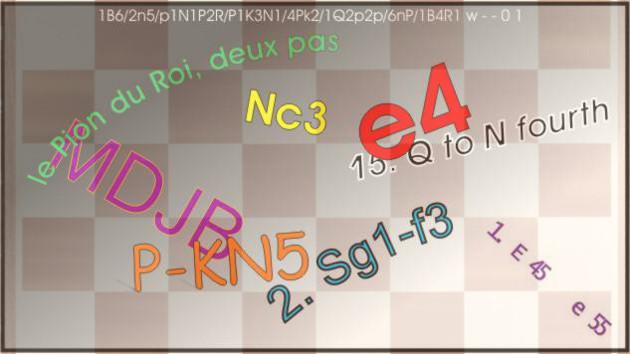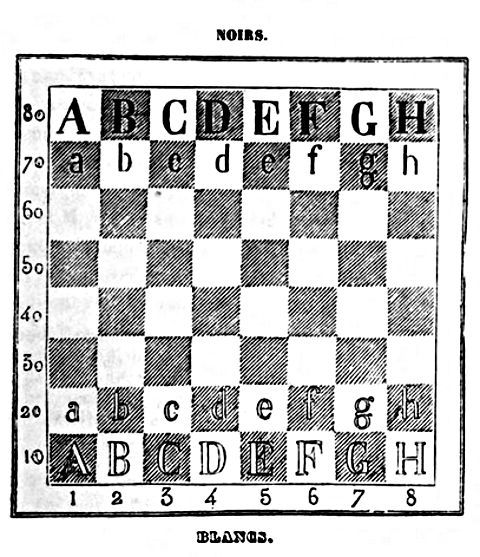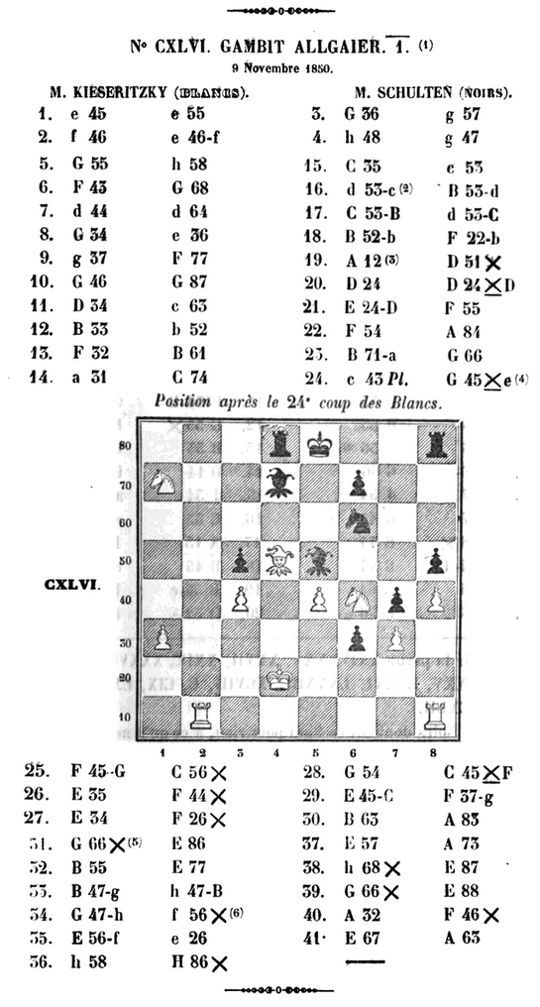
Notation
Many players today remember using Descriptive Notation. Descriptive is a relative notation in which the moves are described relative to each side. White might say, "pawn to King four" (1.P-K4) and Black could response with exactly the same move, 1...P-K4. Each player moved his King's pawn two spaces. Algebraic is a fixed or absolute notation. Each square has a name and the landing square is designated in each move. White's 1. P-K4 becomes 1. e4 and Black's reply becomes 1...e5.
Most people believe Algebraic Notation came into existance with the advent of computers and, in fact, starting July 1,1997 FIDE made Standard Algebraic Notation the required method of recording moves. But Algebraic Notation has been around since before the Middle Ages when Chess was still Shatranj. Throughout the years, both Descriptive and Algebraic Notations have been employed — as well as other, sometimes rather strange, methods of recording moves.
Descriptive notation was the most widely used notation by both the Musilms (Shatranj) and the Mediæval (Old Chess) players but Algebraic notations were not unknown and were used on occasion.
The image below shows the coordinate system employed in a MS from Paris in 1173.
Below that is an image showing the coordinates from Rechenmeister Jacob Köbel's 1520 "Schachzabel Spiel," a German book of Mediæval chess. The coordinates are all comprised of letters for both the ranks and files, rather than the letter-number coordinates we're used to.

MS. Paris 1173

Jacob Köbel 1520
An example of Ruy Lopez's Spanish Descriptive Notation:

A page from Greco — Orleans Ms. No.17 circa 1624-34, shows the Italian Descriptive Notation:

Francis Beale compiled and translated Greco's manuscripts in a work entitled "The Royall Game of Chesse-play" in 1656. Below is an example of how he described the moves in a game:


Philip Stamma, a Syrian from Aleppo who lived in France in the 1730s and then moved to England in the 1740s, reintroduced Algebraic Notation to Europe in 1737 through his "Essai sur le jeu des echecs" :

André Danican Philidor, who thought little of Stamma, having defeated him very convincingly in a match in 1747, published his own book two years later, expressly avoiding Stamma's Algebraic Notation:

from the 1752 edition of Philidor's "Analyse"
Strangely enough, the Société des Amateurs, comprised mainly of the best players at the Café de la Régence, all of whom were well acquainted with Philidor — Bernard, Carlier, Leger and Verdoni were its leading members — published a treatise on chess in 1775, "Traite des Amateurs," which pointedly followed Stamma's Algebraic Notation:

The French, however, didn't embrace Algebraic Notation. La Palamède, Labourdonnais' periodical used a Descriptive Notation:

from "La Palamède," 1837
19th century Russia used mainly, maybe exclusively, Algebraic Notations. But sometimes they took a peculiar turn. The 1852 English translation of Carl Jaenisch's 1843 "Analysis of the Openings of the Game of Chess" used the following notation:





Here is a game between Kieseritzky and John Schulten.
[X denoted "check;" XX denotes "mate;" hyphen (-) denotes capture]

Dr. J. W. D. Wildt, professor at Göttingen proposed this notation in 1803:

from "Ben-Oni, oder, Die Bertheidigungen gegen die Gambitzüge im Schache" 1825
In 1828, Johann Friedrich Wilhelm Koch, in his "Elementarbuch der Schachspielkunst," came up with this notation, upon which Kieseritky may based his own notation. Koch's notation, alsong with Wildt's (above) also formed a basis for the notation later used by the ICCF (International Correspondence Chess Federation) :

An ICCF game may look like this:

The following notation modification appeared in "Household Magazine in 1865. The idea is to differentiate the Queen's R, N and B from that of the King. It never caught on. :


Joseph Steele (L) and Heinrich Friedrich L. Meyer (R)
with their chess composition
(image source: Wikipedia)
In his 1882 book, "A Complete Guide to the Game of Chess," Heinrich Friedrich L. Meyer accentuated the confusing situation in which the lack of any standard notation left the Chess World.





The above references Brownson's "Dubuque Chess Journal," Feb. 1875. Acutally there is a much more interesting notation suggestion in that edition... the one that is popular today and for some of the same reasons. (the letter writer was X. Hawkins of Springfield, Mo.) The figurine notation below differs from current figurine in that the current notation uses Algebraic as a base, while the one below uses Descriptive.


The January 1916 issue of the American Chess Bulletin noted the following notation suggestion in which the squares would simply be numerbed 1-64 (which Meyer, above, dismissed out of hand). Checkers/draughts uses a similar notation, numbering the light squares 1-32:


David Forsyth
(source: "Chess Bouquet")
Chess Problems, by their innate simplicity lend themselves to less convoluted solutions. In fact, the solution that David Forsyth created for his own personal use around 1880 has remained the standard ever since. David Forsyth was a solicitor in the Supreme Court of Scotland who was also secretaty and treasurer of the Scottish Chess Association an active chess organizer. He assisted in editing the chess column for the "Glasco Weekly Herald" and later edited the "Weekly Scotsman."


from "Chess Bouquet" 1897
Even with the advent of the digital age, this same notation -with just slight modifications apapted by Steven J. Edwards for use in his more famous development, the PGN - is still in use today. Now it is called FEN or Forsyth-Edwards Notation. The above problem express in FEN would be:
1B6/2n5/p1N1P2R/P1K3N1/4Pk2/1Q2p2p/6nP/1B4R1 w - - 0 1
One final type of notation, seldom used anymore but which played an important role in its time, is telegraphic chess notation. The objective of this notation was to make is as short as possible. The impetus for this was three-fold: first, to lower the cost and second, to speed up the transmission, and third, to comply with telegraphic requirements. Since trying to explain any these telegraphic notations tends to get quite involved, what's presented below are simply some of the different types developed over the years. This same type of notation was later used in Radio Matches.
It all started with William Watson Rutherford, a solictor and one time president of the London Chess Club who was later knighted.

William Watson Rutherford
(source: "Lancashire at the Opening of the Twentieth Century" 1903)
When he developed his telegraphic notation in late 1880, certain restrictions applied to telegraphy in the UK. According to the "Oxford Companion to Chess," numerals and ciphers were not allowed by the Post Office, so the moves were determined numerically, then tranposed, via a key, into Latin roots which in turn were combined into a single word and sent. As complicated as that sounds, the entire proceedure was actually far more complex. Even the "BCM" (March 8, 1881) begged off trying to give a full explanation and then gave an obtuse truncated one.

Here followed an indecipherable explanation using this board as a "key" (they didn't give the Latin "key" the "OCC" mentioned)

The following year, a correspondent, who apparently was as put off by the complexity of Rutherford's method, suggested a different one:

Chicago native and Chicago Tribune chess editor, Louis Uedemann, who would later hold the Western Championship title twice, developed a telegraph notation in the ealry 1880s. Due to certain flaws in his notation system it was never employed except as a basis for a very similar notation developed by D. Gringmuth of St. Petersburg, Russia.
Steintz gave a nice explanation in his 1889 "Modern Chess Instructor."

Edwyn Anthony (once chess editor for his father's "Hereford Times," later propietor of that paper, inventor of several improvemnts to the printinig process, member of London Mathematical Society, barrister-at-law, president of the Oxford Chess Club, author of books or pamphlets on cricket,billiards, whist and bridge, mathematics and coinage, as well as a friend and student of William Steinitz) wrote a short pamphlet in 1890 called "Chess Telegraphic Code," meant to be a draft of a much large piece he never finished, showing two types of telegraphic code: word and figure (numerical). Both use the 'compas noation' below as a key:


Following this is a very convoluted method involving large tables of the figure code. For the word code, Anthony wrote: "As before remarked, only a specimen of this code is printed [here]. 315 pages are required to make it complete."
Around the same time advertisements can be found for W.W. Morgan's "Telegraphic Chess Code" but the pamphlet itself is elusive :

In 1896 "The Chess Monthly" published a supplement with all the games from the 1895-6 St. Petersburg Tournament as well as an indroduction to a telegraphic chess code invented by F. Startin Pilleau which they called "Dynamic Chess Notation." Again, explaining it would be too complicated, but the idea is to name the piece and to indicate it's move by directional abbreviations. Here are some examples:





Wordsworth Donisthorpe assisted Pilleau in compiling his information
The Uedemann (Gringmuth) Code was also used for radio/cable chess. Below is an image of an actual teletape printout:

reply - the first letter indicates the board, the next 4 repeat the move, the last 4 give the reply move



